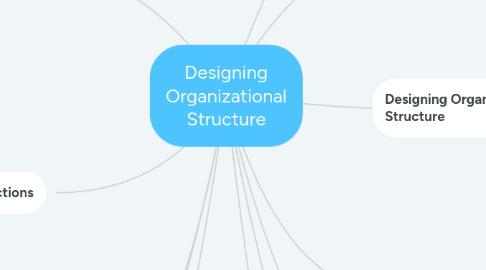
1. Job Characteristics Model
1.1. Skill variety
1.2. Task significance
1.3. Task identity
1.4. Autonomy
1.5. Feedback
2. Grouping Jobs into Functions
2.1. Functional Structure: An organizational structure composed of all the departments that an organization requires to produce its goods or services
2.2. Advantages
2.2.1. Encourages learning from others doing similar jobs
2.2.2. Easy for managers to monitor and evaluate workers
2.3. Disadvantages
2.3.1. Difficult for departments to communicate with others
2.3.2. Preoccupation with Own department and losing the sight of organizational goals
3. Matrix Design Structure
3.1. Matrix Structure: An organizational structure that simultaneously group's people and resources by function and product
3.2. Cross-Functional Team
3.3. Product Team Structure
4. Types of Divisional Structures
4.1. Global Geographic Structure
4.2. Product Structure
4.3. Geographic Structure
4.4. Market Structure
4.5. Global Product Structure
5. Divisional Structure
5.1. An organizational structure composed of separate business units within which are the functions that work together to produce a specific product for a specific customer
6. Job Design
6.1. Definition : The process by which managers decide how to divide tasks into specific jobs
6.2. Job Simplification: The process of reducing the number of tasks that each worker performs
6.3. Job Enlargement
6.4. Job Enrichment
7. Coordinating Functions and Divisions
7.1. Authority
7.2. Hierarchy of Authority
7.3. Span of Control
8. Tall and Flat Organizations
8.1. Tall Organization
8.1.1. Many levels of authority relative to company size
8.2. Flat Organization
8.2.1. Fewer levels of authority relative to company size
9. Allocating Authority
9.1. Span of Control: The number of subordinates who report directly to a manager
9.2. Line Manager: Someone in the direct line or chain of command who has formal authority over people and resources
9.3. Staff Manager Someone responsible for managing a specialist function, such as finance or marketing
10. Centralization and Decentralization of Authority
10.1. Decentralizing Authority
10.2. Integrating Mechanisms
11. Strategic Alliances
11.1. Strategic Alliance
11.2. B2B Network Structure
11.3. Outsource
11.4. Boundaryless Organization
11.5. Knowledge Management System
12. Designing Organizational Structure
12.1. Organizing
12.1.1. The process by which managers establish the structure of working relationships among employees to achieve goals
12.2. Organizational design
12.2.1. The formal system of task and reporting relationships that coordinates and motivates organizational members so that they work together to achieve organizational goals
12.3. Organizational Structure
12.3.1. Formal system of task and reporting relationships that coordinates and motivates organizational members so that they work together to achieve organizational goals
